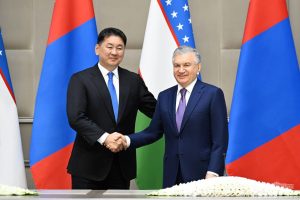For the first time, the president of Mongolia paid a state visit to Uzbekistan. On June 23, President Khurelsukh Ukhnaa, arrived in Uzbekistan for a three-day visit. As part of the visit, Khurelsukh discussed greater trade cooperation with Uzbek President Shavkat Mirziyoyev, and also visited Khiva. Alongside the president, a delegation of more than 40 Mongolian leaders of small and medium-sized enterprises also arrived in Uzbekistan to explore new market opportunities. During the trip, Khurelsukh inaugurated the new Embassy of Mongolia in Tashkent as part of efforts to develop closer diplomatic ties.
Khurelsukh’s meeting with Mirziyoyev was an opportunity to strengthen bilateral trade relations ahead of two important events: the Mongolia Economic Forum on July 8-9 and the Shanghai Cooperation Organization Heads of State Meeting in Astana, Kazakhstan, on July 3-4. Mongolia has been an observer in the latter since 2004.
The trip yielded some important deliverables and the two leaders covered a lot of ground in their discussions, including aiming to increase trade by five to ten times in the coming years, developing joint trade houses, and exploring cooperation in the mining, energy, transport, education, and technology sectors. According to Mirziyoyev, “Mongolia is our traditional and reliable partner in the Asian region. Uzbek-Mongolian relations are built on the principles of friendship, mutual respect and support, and do not depend on the situation.”
The Mongolian Foreign Ministry says that Uzbekistan is currently one of the largest markets for Mongolia in the Central Asian region, the first being Kazakhstan. The volume of bilateral trade between Uzbekistan and Mongolia reached $10.4 million in 2022.
Prior to the trip, Mongolia and Uzbekistan have been increasing the pace of their diplomatic meetings. On June 18, an Uzbek delegation led by the Uzbek Minister of Mining and Geology B.F. Islamov went to Mongolia to meet with representatives of the National Chamber of Commerce and Industry of Mongolia and discussed issues of bilateral economic cooperation. Last year both sides agreed to simplify transit to and from China via Mongolia and upgrade road and air transport.
From a geopolitical point of view, the two countries have a similar strategic position and mutual opportunities in the international arena – both landlocked countries are sandwiched between China and Russia, either physically or politically, and also seek to balance with the West as a “third neighbor.” Russia and China are also the largest trading partners of Mongolia and Uzbekistan, although Tashkent has relatively more options to play with.
Current developments such as the Russian invasion of Ukraine and continued instability of Afghanistan suggest that the demands placed upon Mongolia and Uzbekistan are changing. One answer lies at the intersection of their capabilities. The value, vulnerability, and priority of Uzbekistan and Mongolia in terms of their worth to Russia, China, and the West must be carefully assessed. Competition is to be expected.
Indeed inter-state competition has intensified substantially between the two landlocked countries and the region as a whole. A key area of competition is the export of raw materials, in particular products of the mining and agricultural sectors, which makes them serious competitors in the global raw materials markets. Another obstacle to expanding cooperation is logistics. There is no direct railway connection between Mongolia and Uzbekistan, as well as the other Central Asian states of the region; basically all trade from Mongolia to the Central Asian states runs through Novosibirsk, Russia.
Nevertheless, there is an opportunity for Uzbekistan and Mongolia to assume more responsible roles in the region and their similar geopolitical situation could be the catalyst for the formation of like-minded partnerships to navigate the conflicting priorities of Russia, China, and the West. Both countries’ “bridge-building” and transit position is an important element to balancing these large powers. Their efforts to appeal to the West as key reliable partners that can help bring stability to the region in terms of economic development, institution building and resolution of humanitarian crises.
Russia’s and China’s size, power, and geographic proximity to Mongolia and Uzbekistan mean that they can never be dismissed as dominant and potentially aggressive actors in the region. Russia and China will both without doubt continue to be a major political and economic force in Mongolia and Uzbekistan. But their dominance is far from inevitable or assured.
What is more certain is that the wider Central Asia region will be one of the greatest battlefields of the growing Russia-China-West competition. In a sense, this is potentially one way in which superpower competition is not entirely negative for the Central Asian region. Many countries in Central Asia are likely to play one camp off the other, in the process attempting to win for themselves greater attention, influence, financing, and economic opportunities. Mongolia, Uzbekistan, and the wider region that languished in a unipolar world, deprived of leverage, can now have their voices heard and respected.
Mongolia and Uzbekistan must work together and learn from each other’s mistakes and successes as they craft new foreign policy strategies and solutions to the evolving situation. Achieving that goal, however, will require some new thinking in Mongolian and Uzbek foreign policy circles and their approach to these competing powers.
Indeed, policymakers in Ulaanbaatar and Tashkent should not waste this opportunity to redefine their East and West relationship. Both leaders should learn from their pasts and chart a different trajectory. In particular they should acknowledge that different interests exist, focus on economic areas where interests align well, and pragmatically maximize efforts to align commitments. This playbook now needs to become the cornerstone of their foreign policy agenda.

































